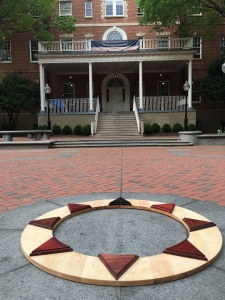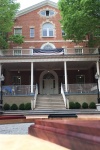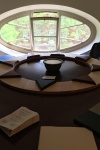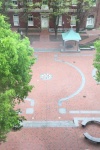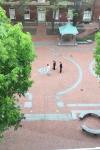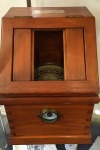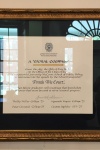“Heartwood: The Moral Compass of Old North” raises questions about race in the context of Georgetown as a historical institution. Here, Ken Wake, a graduate candidate in CCT, intends to explore how we understand “sacred” space in the context of a sometimes “profane” past.
For much of its history, Georgetown—like many other institutions of its age and prestige—has ignored, often actively, the fact that its current reputation is at least partially predicated on a history that includes institutional slavery. In the case of Old North, the literal foundation of the structure was built, at least in part, on the backs of slaves. Recent developments have brought this long overlooked or ignored history to the fore and have led to, among other things, the work to rededicate two buildings previous named for past university presidents involved in the sale of slaves.
In this project, the artist hopes to juxtapose the image of Old North as a highly mediated, sacred space for Georgetown—the steps from which U.S. Presidents have delivered speeches and the halls where dignitaries are often received—with the profane history of slavery that exists simultaneously in the same space. To this end, he plays with the idea of a “moral compass” by constructing a new moral compass of Old North from padauk, bubinga, and ebony—woods sourced from Western Africa, the ancestral home of many of the slaves who found their way to the Hill Top—and hard white maple—sourced from Maryland and representing the privileged white students, faculty, and staff who have benefitted from this institutional slavery.
The McCourt School of Public Policy was officially dedicated on October 8, 2013. During the Foundation Exercises for the school, Frank McCourt spoke of his wish that the students be guided by a strong moral compass during their education, careers, and life. On May 28, 2015 and in celebration of the 40th anniversary of their graduation, McCourt’s classmates donated a “moral compass” to the school, on behalf of its named benefactor.
Given Georgetown’s history and involvement with slavery, including during the construction of Old North, the idea of a “moral compass” in the context of this space seemed one needing of exploration. As a reflection on this idea, I created by hand a new “moral compass,” constructed with a base of white hard maple, from Maryland and ebony, padauk, and bubinga from Western Africa, the former home of the majority of the slaves brought to labor in the new world.
— Ken Wake
